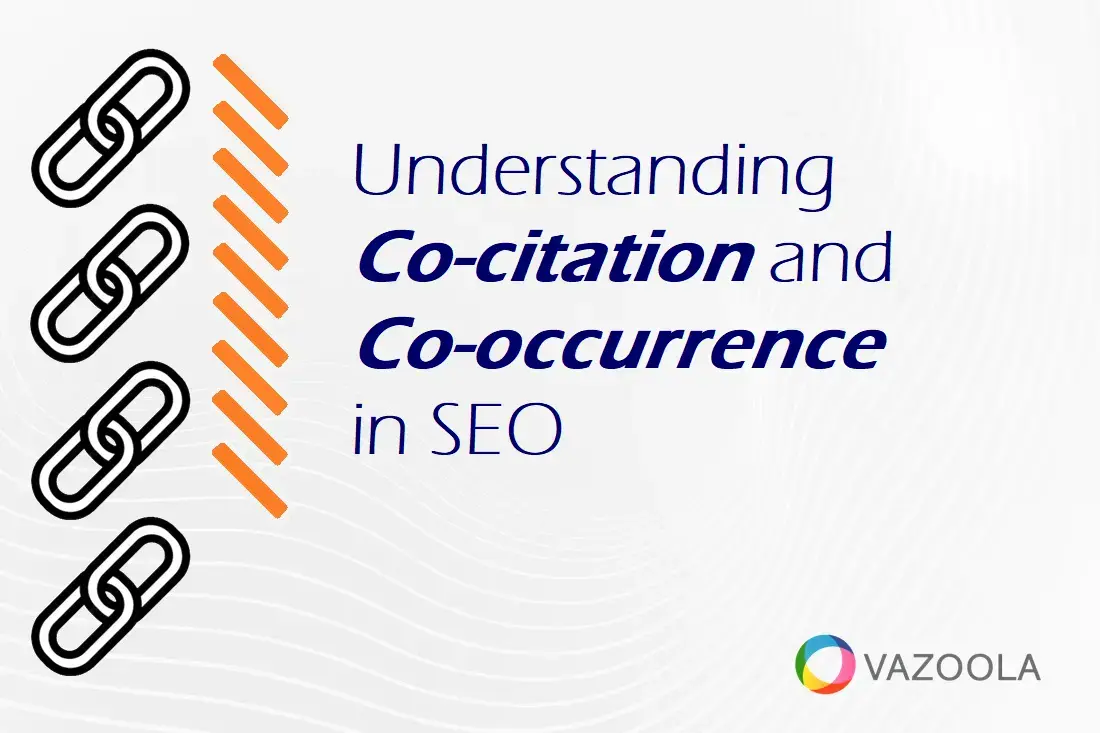Understanding Co-citation and Co-occurrence in SEO
Jul 07, 2025
Written by Casey Bjorkdahl

Casey Bjorkdahl is one of the pioneering thought leaders in the SEO community. In 2010, Casey co-founded Vazoola after working for a Digital Marketing Agency for five years in New York City. Vazoola is now one of the fastest growing and most widely recognized SEO marketing firms in the country.

Search engine optimization continues to evolve, and staying ahead means using more than just traditional link-building techniques.
Co-citation and co-occurrence are two powerful — but often overlooked — concepts that support a website’s authority and relevance. These methods don't replace link building but work alongside it to help search engines better understand content and context.
Used correctly, co-citation and co-occurrence can increase content visibility and organic reach. Still, you might be wondering what they are, how they work, and how to use them to support your SEO strategy. Keep reading to also find out what they aren’t, so you avoid common misconceptions.

Key Takeaways
-
Co-citation and co-occurrence are SEO techniques that help Google understand the relationship between websites and keywords—even without direct links.
-
They work best when used alongside link building, not instead of it.
-
These strategies support content authority and relevance and should be part of a balanced SEO plan.
Table of Contents
The Role of Co-citation and Co-occurrence in SEO
SEO is not a single technique; it’s a combination of strategies and ranking factors that together help search engines evaluate content.
While keywords and backlinks still matter, Google’s algorithm has become more advanced. Now it can understand context, connections between pages, and keyword relationships across the web.
That’s where co-citation and co-occurrence come in. These techniques help search engines see which topics, sites, and terms are related, without needing an exact match keyword or backlink.
Co-citation and co-occurrence support trust and authority. They help reinforce signals already created by other SEO efforts, which improves SEO rankings. But they do not work in isolation, nor are they meant to replace proven tactics like link building.

What Is Co-citation in SEO?
Co-citation happens when two websites are mentioned together by a third-party source. These mentions signal to search engines that the two entities are related—even if no hyperlink connects them.
Let’s say a blog post talks about Company A and Company B in the same paragraph, praising their services. Even if the blog only links to one of them, search engines may assume they’re both relevant in the same topic area. Over time, this perceived connection can help boost both companies’ visibility in related search queries.
Think of co-citation as social proof on a web-wide scale. If enough websites refer to two brands or sources in similar contexts, Google will start to group them together thematically.

When targeting co-citation, don’t just rely on brand mentions. Incorporate structured data and schema markup to reinforce your entity’s identity. This helps search engines better recognize and connect mentions of your business with relevant concepts—even if those mentions happen without a backlink.
What Isn’t Co-citation?
Co-citation is often confused with traditional link building, but the two are not the same. Link building relies on acquiring direct backlinks. Co-citation does not.
In fact, co-citation doesn’t require a hyperlink at all. It works through textual mentions, names, or phrases that appear in similar places on the web. Search engines pick up on these associations using context and frequency.
A common misconception is that co-citation alone can replace link building. While helpful, co-citation lacks the strength of a direct link. It’s a supporting signal, not a standalone tactic.
As Google's algorithm prioritizes link quality and content relevance, co-citation provides added clarity—but it can't do all the work.
Examples of Co-citation in Action
Consider a situation where multiple marketing blogs reference both SEMrush and Ahrefs when discussing keyword tools. Even if a post only links to one of those tools, both are mentioned together repeatedly.
Over time, this shared presence builds authority. Google begins to associate the two brands with the same topic—keyword research—and both benefit in related searches. Co-citation, then, becomes part of their digital footprint.
Another example involves academic institutions. If articles across the web regularly mention Harvard and Stanford in the same discussions about elite education, even without links, Google understands they’re top-tier universities.
That sort of understanding supports rankings when users search for top universities, even on third-party content.

Set up alerts for when your competitors are cited alongside key industry terms. Use tools like Brand24 or Mention to identify unlinked citations, then evaluate how often your brand appears in similar contexts. This can help you locate missed opportunities for co-citation and adjust your content strategy accordingly.
What Is Co-occurrence in SEO?
Co-occurrence focuses on keyword relationships. It refers to the way related terms appear together in content across different websites. The goal is to help Google understand what your content is really about by showing context through natural word pairings.
Let’s say your article is about electric vehicles. If it also includes terms like “battery range,” “EV incentives,” and “charging stations,” Google sees the bigger picture. These related terms signal to the algorithm that your content is deep, relevant, and valuable.
This is different from matching exact keywords. Co-occurrence works by clustering semantically related terms that support your main topic.

Run your content through NLP APIs (like Google's Natural Language API or IBM Watson NLU) to identify whether the right semantic clusters are showing up. These tools can flag missed relationships between key terms and help ensure that co-occurrence is working at scale across your content portfolio.
What Isn't a Co-occurrence?
Some people confuse co-occurrence with keyword stuffing. But these two tactics aren’t the same.
Stuffing involves repeating the same term excessively to try and manipulate rankings. Co-occurrence, on the other hand, is about using a wide range of related terms that provide a better reading experience.
Another SEO mistake is to force keywords into content where they don’t belong. That can harm readability and even hurt rankings. Co-occurrence should happen naturally. When you write a well-rounded article, related terms tend to appear on their own.
You can see examples of this kind of optimization in Google's own documentation about search quality, which emphasizes meaningful content over keyword tricks.
Examples of Co-occurrence in Action
A food blogger writing about sourdough bread might include words like “wild yeast,” “starter,” “proofing,” and “gluten structure.” They may not mention “bread” in every sentence, but the context is clear. Google reads those related terms and determines that the article is about sourdough.
In the health niche, an article about “high blood pressure” might include “hypertension,” “cardiovascular health,” and “sodium intake.” When Google sees those phrases together, it strengthens the article’s relevance for users searching for any of those terms.

Pick a top-performing competitor article in your niche. Use tools like Surfer SEO or Clearscope to extract the most frequently co-occurring phrases. Then create new content that covers similar terms with better structure, more depth, or updated information to outperform in SERPs.
Co-citation and Co-occurrence vs. Link Building
Link building remains a pillar of SEO. No mention of co-citation or keyword relevance can fully replace the power of a high-quality backlink. But co-citation and co-occurrence do fill in some key gaps.
The two strategies provide additional signals that reinforce what your backlinks are saying. They support your authority, increase relevance, and help Google make sense of your site—even if you’re not the one getting the direct link.
Each method has strengths:
-
Link building delivers direct equity and drives traffic.
-
Co-citation helps establish authority through associations.
-
Co-occurrence builds topic depth and contextual clarity.
A balanced SEO strategy weaves them together. You can get ideas for building links in our Ultimate Link Building Guide, learn how to get links, and start your link building campaign by reviewing best practices to start link building.

Leveraging Co-citation and Co-occurrence
Co-citation and co-occurrence won’t replace traditional link building. But they certainly can supercharge it.
By naturally building references across the web and writing content that includes keyword-rich context, you help search engines understand your authority and relevance—without needing a direct link every time.
Marketing managers, agencies, content creators, and business owners can all benefit from adding these strategies into the mix. Sure, they’re subtle. But when combined with core SEO tactics, they can make a measurable difference.

Correlate ranking fluctuations with known co-citation and co-occurrence patterns by tracking specific URLs and keyword clusters over time. When rankings shift due to algorithm updates, evaluate whether content with richer term associations or more citation-based context is gaining ground. This helps you adapt future content with greater precision.



